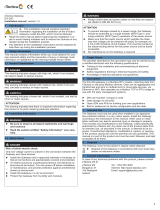
8 Table of Contents WAGO-I/O-SYSTEM 750
758-874/000-131 WAGO-I/O-IPC-C6
Manual
Version 1.0.0
18.2.5.5 Data Exchange Module................................................................ 240
18.2.5.6 SSI Transmitter Interface Modules.............................................. 240
18.2.5.7 Incremental Encoder Interface Modules...................................... 241
18.2.5.8 DC-Drive Controller.................................................................... 243
18.2.5.9 Stepper Controller........................................................................ 244
18.2.5.10 RTC Module ................................................................................ 245
18.2.5.11 DALI/DSI Master Module........................................................... 245
18.2.5.12 EnOcean Radio Receiver............................................................. 246
18.2.5.13 MP Bus Master Module............................................................... 246
18.2.5.14 Bluetooth
®
RF-Transceiver.......................................................... 247
18.2.5.15 Vibration Velocity/Bearing Condition Monitoring VIB I/O....... 248
18.2.5.16 KNX/EIB/TP1 Module................................................................ 248
18.2.5.17 AS-interface Master Module ....................................................... 249
18.2.6 System
Modules ............................................................................... 251
18.2.6.1
System Modules with Diagnostics............................................... 251
18.2.6.2 Binary Space Module .................................................................. 251
18.3 Mailbox Modules .................................................................................. 252
19 Appendix................................................................................................... 253
19.1 WAGOConfigToolLIB.lib.................................................................... 253
19.1.1 Calls for the "WAGOConfigToolLIB.lib" Library .......................... 255
19.2 WagoLibNetSnmp.lib ........................................................................... 275
19.2.1 snmpRegisterCustomOID_INT32() ................................................. 276
19.2.2 snmpRegisterCustomOID_STRING() ............................................. 277
19.2.3 snmpRegisterCustomOID_UINT32() .............................................. 278
19.2.4 snmpGetValueCustomOID_INT32() ............................................... 279
19.2.5 snmpGetValueCustomOID_STRING() ........................................... 280
19.2.6 snmpGetValueCustomOID_UINT32() ............................................ 281
19.2.7 snmpSetValueCustomOID_INT32()................................................ 282
19.2.8 snmpSetValueCustomOID_STRING() ............................................ 283
19.2.9 snmpSetValueCustomOID_UINT32()............................................. 284
19.2.10 Feedback........................................................................................... 285
19.2.11 Example Program "Test.pro"............................................................ 286
19.3 WAGO_DPM_01.lib
............................................................................ 289
19.3.1 DPM_VERSION
.............................................................................. 290
19.3.2 DPM_REDUNDANCY ................................................................... 291
19.3.3 DPM_GLOBAL_CONTROL .......................................................... 293
19.3.4 DPM_READ_INPUT....................................................................... 295
19.3.5 W DPM_READ_OUTPUT.............................................................. 297
19.3.6 DPM_SET_SLAVE_ADDRESS
..................................................... 299
19.3.7 DPM_MSAC1_READ
..................................................................... 301
19.3.8 DPM_MSAC1_WRITE ................................................................... 303
19.3.9 DPM_MSAC1_ERROR................................................................... 305
19.3.10 FUNCTION_CODE......................................................................... 306
19.3.11 DPM_ERROR_CLASS.................................................................... 307
19.3.12 APP_CODE...................................................................................... 308
19.3.13 ACC_CODE..................................................................................... 309
19.3.14 RES_CODE...................................................................................... 310
19.3.15 DPM_CONTROL............................................................................. 311
19.3.16 MODE_INDICATION..................................................................... 312
19.4 mod_com.lib.......................................................................................... 313




















